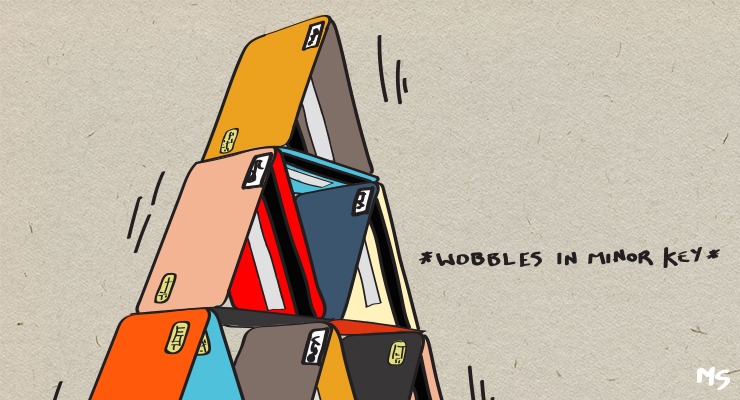
After years of hype, boosterism for “disruption”, tech bro PR and repeated overuse of “gamechanger”, investors are learning the hard way that the basics of investment and finance don’t change.
The fundamental flaws of the buy-now-pay-later sector — aka lay-by for impatient people — which has hitherto enjoyed its status as a market darling and a free-rider on financial regulation (with buffoons like Liberal Senator Andrew Bragg leading the charge against regulation), is now going down in flames.
Take media favourite Afterpay, which was taken over by Square (now Block) in a US$29 billion deal last year that handed its tech bro creators billions. Now its value has fallen by about 80%, a fall similar to the loss of value by rivals/copycats Zip, Sezzle, and US BNPL group Affirmed.
The reason? Some financial basics. Block revealed earlier this year that Afterpay had run up bad debts of $176.8 million in the six months to December, from $72.1 million a year earlier. Afterpay recorded a net loss of $345.5 million for the six months to December 31, from $79.2 million loss it reported in the prior corresponding half. Its pre-tax loss also surged to $501.9 million from $76.2 million a year earlier.
In fact the entire business model of BNPL is inherently fragile — and that’s before regulation.
The crypto sector is also displaying the fact that hype can’t defeat basic laws of economics. From a value of US$2.7 to US$3 trillion last October/November, the crypto sector’s value fell below US$1 trillion this week and more on Tuesday.
More important that its plummeting value, however, is that the past six weeks has seen the rationale for crypto as a decentralised form of money, free of government controls (and, therefore, protections) evaporate. Crypto has shown a dangerous correlation to the usual drivers of markets — confidence, credibility, cost and momentum.
The sell-off in recent days comes as investors rotate out of the riskiest assets due to macroeconomic headwinds and rising interest rates. Cryptocurrencies are not proving to be any sort of safe haven for investors who have believed the hype that they would be “just like gold”. For that matter, in the current inflationary surge, even gold isn’t a safe haven.
When someone had the idea of combining crypto with traditional lending — backed, inevitably, by an app — the risks multiplied. This week, Florida’s Celsius Network, one of the biggest lenders in the crypto sector, stopped redemptions of crypto transfers — exactly like a conventional bank closing its doors and refusing to give depositors back their money during a bank run.
Celsius claimed to have 1.7 million customers and advertised to its users that they can get a yield of 18% through the platform as it lent their cryptocurrencies out to institutions and other investors. A classic case of “if something sounds too good to be true, it is”. The company had US$11.8 billion worth of assets as at May 17, down from more than US$26 billion in October last year, according to its website.
These days deposit insurance and strong prudential controls are in place to stop bank failures. There are no protections in place for cryptolenders. Hell, their whole rationale is that they are taking on banks and are unregulated by governments.
Turns out, regulation has some benefits after all. But “disruption”, hey?
Much of the media coverage of BNPL, crypto and fintech — especially in The Australian Financial Review — has championed “disruption” as a good in and of itself, regardless of whether a business model is sustainable or flies in the face of basic financial rules. That in turn has encouraged incumbent institutions to dabble in disruption themselves. Last November, Commonwealth Bank CEO Matt Comyn enthusiastically announced that CBA was planning to offer crypto trading services to its customers.
By May this year the enthusiasm had vanished and the move postponed. It was “clearly a very volatile sector”, Comyn said then, noting: “There is a lot of interest from regulators.”
If the CBA had been successful in starting its November venture, its rivals would have followed like lemmings. Perhaps key regulators like APRA and the Reserve Bank recoiled in horror at the idea.
The collapse of cryptocurrencies and their associated dodgy ventures, and the big fall in BNPL companies, should be a big nail in the coffin of fintech ideas that do not address the basics of finance, and which rely on a lack of regulation — backed by useful idiot political spruikers and journalists — to “disrupt” incumbents.
No one loves banks, but they are tightly regulated for a reason, and “disruption” isn’t good in and of itself without a sound business model behind it. Finance isn’t like getting a taxi or having your pizza delivered. The stakes for getting it wrong are high personally and, in aggregate, high systemically.









So after the collapse in cryptocurrency, there is still $1trillion invested in an ‘asset’ that is mere idea, relates to nothing else of conventional value and is not guaranteed by anyone who has assets? My long time scepticism for this nonsense is proving valid. And I thought for a long time I was just not smarter enough or imaginative enough to get it.
Cryptocurrency…………
……… a cheque drawn on the Bank of Nowhere.
Cash it at your peril.
What is the difference between sub prime mortgage and crypto?
BPNL has a distinctive odour, you can’t get away with lending money to folk who can’t or won’t pay it back, it is permeating both ships.
Sub prime has ‘some’ asset backing?
Good article gentlemen, but merely restating what people who earned their money have been saying for years…there are no free rides!
Another business to watch is Uber. Been around a decade & has accumulated losses of $35billion & never ever declared $1 of profit with its failed spin lies & deception business model. I would tip that Uber is very close to failing ie another ENRON.